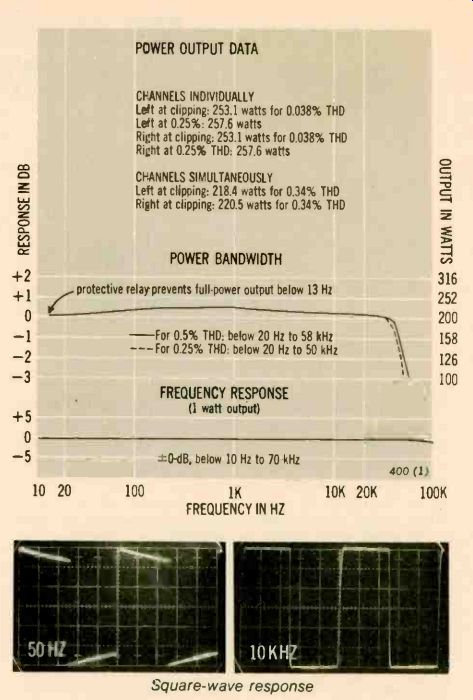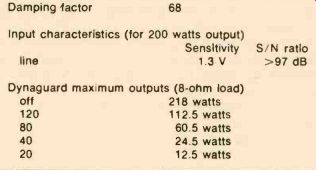
Dynaco's Super Amplifier Kit
The Equipment: Dynaco Stereo 400, a basic stereo power amplifier in metal case. Dimensions: 17 by 7 inches (front panel); 14 inches deep. Prices: $499 as a kit; $649 wired; optional front panel with two output meters (Model MC-4) $85 (may be added by owner to either kit or factory-built version); factory-built version with MC-4 panel and meters pre-installed (as Model 400 M / A) $749. Warranty: factory-built units, one year on parts and labor, shipping paid one way; kit-built units, one year on parts, nominal service fee, shipping paid both ways by owner. Kit warranty void if unit is not completely assembled or if other than rosin core solder has been used. Manufacturer: Dynaco, Inc., Coles Rd., Blackwood, N.J. 08012, USA.
Comment: Over the years Dynaco has gained an estimable and well-deserved reputation for producing high performance audio components in both kit and factory-assembled form. The kits offer significant savings for the do-it-yourselfer; the assembled versions, despite their higher cost, still represent better than average value. In previous reports on Dynaco products HF has never had occasion to fault any, and indeed Dynaco equipment generally has always been regarded as among the best available of its type.
So it is with the new Stereo 400, the company's largest and most powerful amplifier to date. This unit-superbly designed and crafted, and conservatively rated takes its place among the new breed of "super amplifiers" that offer unprecedented high power combined with extremely low distortion, excellent stability and reliability, very wide band response, fail-safe circuitry, and other features of interest to audio perfectionists.
As a power or "basic" amplifier, it is intended of course for use after a separate preamp. (It requires a bit more than 1 volt of input signal for full rated output.) Front-panel features include a power off/on knob, separate level controls for each channel, and high- and low-frequency filter switches that operate on both channels simultaneously. There are speaker fuse-indicators, a high-temperature indicator, a pilot lamp, and a "Dynaguard" control that you may operate to limit the maximum power delivered to the unit's load, which means you can use this amplifier safely to drive just about any speaker system you choose. The nominal full stereo power output is rated at 200 watts per channel into 8-ohm loads; 300 watts per channel into 4-ohm loads. The amplifier also can be "strapped" (the stereo inputs and outputs combined) to deliver monophonic power of 600 watts into an 8-ohm load.

---------- Optional front panel for Dynaco Stereo 400 amplifier
features two meters for monitoring output. Meters have average-reading movements
with VU ballistics. Panel may be bought with amplifier or added to unit
at a later date.
----
REPORT POLICY
Equipment reports are based on laboratory measurements and controlled listening tests. Unless otherwise noted, test data and measurements are obtained by CBS Laboratories, Stamford. Connecticut, a division of Columba Broadcasting System, Inc. one of the nation's leading research organizations The choice of equipment to be tested rests with the editors of HIGH FIDELITY Manufacturers are not permitted to read reports in advance of publication and no report, or portion thereof, may be reproduced for any purpose or in any form without written per mission of the publisher. All reports should be construed as applying to the specific samples tested, neither HIGH FIDELITY nor CBS Laboratories assumes responsibility for product performance or quality.
----------
Each output channel is fused to protect the loudspeaker being driven (and without affecting its performance or reducing the damping factor). Should a fuse fail, the appropriate lamp on the front panel will light up.
Additional speaker protection is furnished by the time-delay circuit that operates when the unit is turned on and that not only safeguards the speakers from sudden signal surges, but also eliminates the annoying "thump" sometimes heard when turning on a high-powered amplifier. The unit has built-in sensing circuits and protection relays that instantly disconnect the speakers should any abnormalities develop at the output. These relays open at subsonic signals at full power (something that never occurs in normal listening, of course) and prevented power-bandwidth measurements below 13 Hz. The Dynaguard feature involves a special circuit (in addition to the front-panel control) that continuously monitors the amplifier's output and will limit it if it exceeds the permissible reference level.
Our test unit was built (without the meters) from a kit and sent for testing at the lab, where, as the accompanying data show, it verified or exceeded its published specifications. For instance, at the 200-watt output level, distortion never came near the rated value of 0.25%, and the same sterling performance was maintained at half-power and 1 / 100-power output levels.
The IM curves are exemplary, and the frequency response literally a ruler-straight line from below 20 Hz to nearly 100,000 Hz. And so on.
Our kit-builder reports that the job of building the amplifier took 13 1/2 hours, working a few hours at a time on successive evenings. Many of the circuit parts come pre-mounted on boards, and much of the work consists of fitting the boards in place and interconnecting them.
There were a few tight places and a few wire-lengths indicated in the manual that our builder had to increase "to make ends meet." In general, he feels that a rank novice might get confused at some points during the process of assembly but anyone who has worked on an audio kit before should be able to complete this one with no trouble.
In listening tests, the Stereo 400 is superb. It is difficult, as we have commented in the past, to describe how a truly great amplifier sounds. One is aware of an "opening up" of the reproduced signal, of flawless detail presentation of effortless handling of loud and/or complex musical passages, of a sense of realism and closeness to the program material that spur such statements as "the reproducing system vanishes; all that's left is the program itself." We have no desire to be drawn into the endless controversy among audio buffs as to which amplifier is best. But certainly it seems valid to say that the Dynaco Stereo 400 is as good as any "best" at the present state of the art.

----- HARMONIC DISTORTION CURVES; INTERMODULATION CURVES

------ POWER OUTPUT DATA; Square-wave response

Dynaco Stereo 400--Additional Data
-------------
(High Fidelity, Apr. 1975)
Also see:
Burwen DNF (review, Apr. 1975)
Tempest loudspeaker (ad, Apr. 1975)